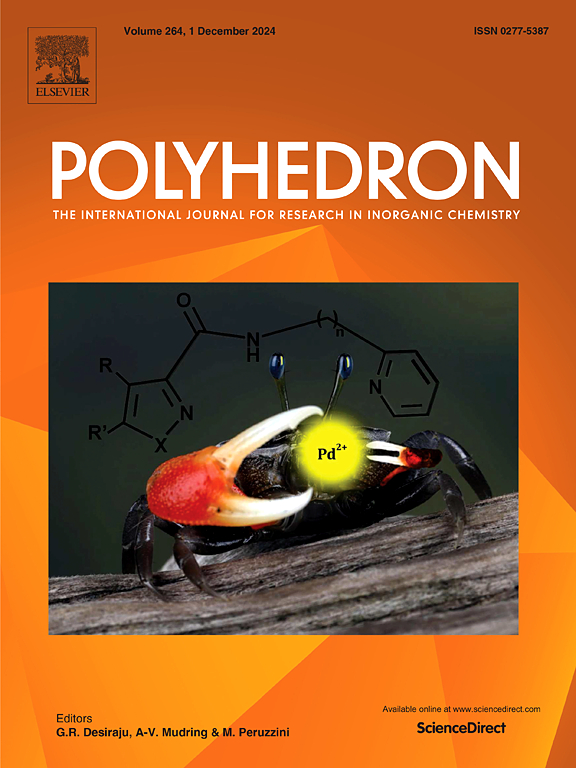Synergistic effect of pulsed-laser-deposited PbS nanoparticles on porous silicon for indoor air remediation
IF 2.6
3区 化学
Q2 CHEMISTRY, INORGANIC & NUCLEAR
引用次数: 0
Abstract
This study investigates the photocatalytic performances of incorporating lead sulfide (PbS-NPs) onto porous monocrystalline silicon (PS/c-Si) structures (PbS-NPs/PS/c-Si) for volatile organic compounds (VOCs) removal from indoor air. Here the butane-2, 3-Dione (BUT: C4H6O2) is chosen as pollutant model due to its presence in the cheese industry. The porous silicon (PS) layers were synthesized using the electrochemical anodization procedure on the mono-crystalline silicon (mc-Si) substrate. The deposition of PbS-NPs on the porous silicon layer was performed using the pulsed laser deposition (PLD) technique. The average size of PbS-NPs varied from 9 nm to 16 nm as the number of laser ablation pulses (NLP) increased from 500 to 10,000. The Scanning electron microscopy (SEM) analysis indicated that an increase in laser ablation pulses leads to the aggregation of the PbS-NPs. Atomic Force Microscopy measurements showed that the root means square (RMS) roughness of the PbS-NPs/PS/c-Si structure increased with NLP and reached its maximum value at NLP = 5000, which is probably due to the aggregation of PbS-NPs and the increase in NP size. The adsorption spectra indicated that the PbS nanoparticles possess an indirect optical bandgap ranging from 0.86 eV to 0.93 eV. This bandgap reflects excitonic transitions, which are strongly influenced by surface state defects, especially in smaller NPs (NLP < 2500). At the optimized PbS-NPs laser pulses (NLP = 5000), the catalyst exhibited a high photocatalytic efficiency for BUT removal, reaching 82 %.

脉冲激光沉积PbS纳米颗粒对多孔硅室内空气修复的协同效应
本文研究了在多孔单晶硅(PS/c-Si)结构(PbS-NPs/PS/c-Si)上掺入硫化铅(PbS-NPs/PS/c-Si)的光催化去除室内空气中挥发性有机化合物(VOCs)的性能。这里选择丁烷- 2,3 -二酮(BUT: C4H6O2)作为污染物模型,因为它存在于奶酪工业中。在单晶硅(mc-Si)衬底上采用电化学阳极氧化法制备了多孔硅(PS)层。利用脉冲激光沉积(PLD)技术在多孔硅层上沉积PbS-NPs。随着激光烧蚀脉冲数(NLP)从500个增加到10,000个,PbS-NPs的平均尺寸从9 nm到16 nm不等。扫描电镜(SEM)分析表明,激光烧蚀脉冲的增加导致PbS-NPs的聚集。原子力显微镜测量结果显示,PbS-NPs/PS/c-Si结构的RMS粗糙度随NLP的增加而增加,并在NLP = 5000时达到最大值,这可能是由于PbS-NPs的聚集和NP尺寸的增加。吸附光谱表明,PbS纳米粒子具有0.86 ~ 0.93 eV的间接光学带隙。这种带隙反映了激子跃迁,激子跃迁受到表面态缺陷的强烈影响,特别是在较小的NPs中(NLP < 2500)。在优化后的PbS-NPs激光脉冲(NLP = 5000)下,催化剂对BUT的光催化效率达到82%。
本文章由计算机程序翻译,如有差异,请以英文原文为准。
求助全文
约1分钟内获得全文
求助全文
来源期刊

Polyhedron
化学-晶体学
CiteScore
4.90
自引率
7.70%
发文量
515
审稿时长
2 months
期刊介绍:
Polyhedron publishes original, fundamental, experimental and theoretical work of the highest quality in all the major areas of inorganic chemistry. This includes synthetic chemistry, coordination chemistry, organometallic chemistry, bioinorganic chemistry, and solid-state and materials chemistry.
Papers should be significant pieces of work, and all new compounds must be appropriately characterized. The inclusion of single-crystal X-ray structural data is strongly encouraged, but papers reporting only the X-ray structure determination of a single compound will usually not be considered. Papers on solid-state or materials chemistry will be expected to have a significant molecular chemistry component (such as the synthesis and characterization of the molecular precursors and/or a systematic study of the use of different precursors or reaction conditions) or demonstrate a cutting-edge application (for example inorganic materials for energy applications). Papers dealing only with stability constants are not considered.
 求助内容:
求助内容: 应助结果提醒方式:
应助结果提醒方式:


